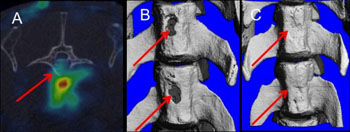Combined Stem Cell and Hormonal Therapy Stimulates Bone Growth and Repair
By LabMedica International staff writers
Posted on 20 Dec 2015
A novel regimen to promote healing of damaged or broken bones is based on combined stem cell and hormonal treatment.Posted on 20 Dec 2015
Parathyroid hormone (PTH) has been shown to induce fracture repair in animals by activating mesenchymal stem cells (MSCs). However, researchers speculated that it would be less effective in patients with fewer and/or dysfunctional MSCs due to aging and related chronic disorders. To address this issue, investigators at Cedars-Sinai Medical Center (Los Angeles, CA, USA) evaluated the potential of combination intravenous MSC and PTH therapy versus monotherapy and untreated controls, in animal models of osteoporotic vertebral bone defects.

Image: A- Labeled stem cells target spinal bone fracture; B- Two spinal bone fractures; C- Complete healing of spinal bone fractures eight weeks post treatment with stem cells and PTH (Photo courtesy of Cedars-Sinai Board of Governors Regenerative Medicine Institute).
In this study, rats and pigs with vertebral fractures received daily injections of PTH for 21 days. During this period, the animals were injected with five doses of mesenchymal stem cells. Control animals received only PTH or MSC injections (monotherapy) or no treatment at all.
Results published in the November 20, 2015, online edition of the journal Molecular Therapy demonstrated that combination therapy significantly increased new bone formation versus monotherapy and no treatment by two weeks. Mechanistically, PTH significantly enhanced MSC migration to the lumbar region, where the MSCs differentiated into bone-forming cells. Thus, PTH functioned as an adjuvant to intravenous MSC therapy by enhancing migration to heal bone loss.
"We have known that used separately, both the stem cells and the hormone each have an effect on the healing process involved in bone fractures," said senior author Dr. Dan Gazit, professor of surgery at Cedars-Sinai Medical Center. "Now, we have learned that the stem cells and PTH are much stronger combined than they are separately."
Related Links:
Cedars-Sinai Medical Center













